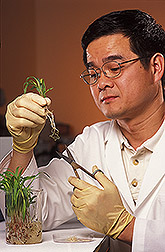High cotton prices appear to be having a spin-off effect on the value of John Faulkner’s 1942 novel, Dollar Cotton.
How much? In the previous decade, you could buy the last reprinting of Dollar Cotton all day long for less than $3 dollars a copy. I know that because I bought a stack of them.
Today, that same book -- and keep in mind, this is a reprinting, not a first edition -- is being offered on Amazon for more than 20 times that amount. And that's for a used copy. One book marketer is offering a never-sold copy for well over $200, also through Amazon.
Unfamiliar with the book? It was largely set in that period around World War I when British mills ran up the fiber’s price over fears that hostilities would block supplies coming from Egypt.
Cotton reached a dollar a pound, which made for heady times in America’s cotton country until the bubble burst and prices fell to almost nothing..
Vast wealth flowed into the Delta, where the story was set. It accelerated the clearing and draining of land in the Midsouth as more acreage shifted into production.
Now, cotton prices are above $1 again, something that’s only happened only a handful of times in the last century.
And as the price of cotton moved above a dollar this year, the value of Faulkner’s book began hitting new highs, too.
I know this because we collect first edition works by John Faulkner, the lesser-known brother of William Faulkner, Mississippi’s literary lion.
We own 3 first-edition copies of Dollar Cotton.
By “we,” I mean my business partner and wife, Debra Ferguson, and myself. I think Debra bought the first John Faulkner first edition, although it wasn’t Dollar Cotton. Like people who collect books or anything else, it becomes a quiet obsession. For me, the quest has been to find more pristine first-edition copies of Dollar Cotton, the only book John Faulkner wrote about the Delta.
Our 3 copies are in various conditions, depending on whether they came from a private collection or a public library. It’s hard to say right now what a first edition would fetch because it’s difficult to find any that are even on the market. A year ago, you could still run across them on a fairly regular basis through various internet sources.
But as the price of cotton started rising earlier this year, I began to sense two things.
- First, demand was increasing. When somebody offered a first-edition Dollar Cotton, it didn’t stay on the market long. There seemed to be a quick turnover on eBay and Amazon.
- Second, the price was edging upward. At one time, we could buy a first edition for as little as $75. The last one I bought cost $150, and that was without a dust jacket.
Supply and demand affects the used and rare book market just as it does the price of cotton. Book merchants sensed somehow that more people wanted to buy
Dollar Cotton. As the supply dwindled, prices moved higher.

And if the market for paperback copies is any indication, the price for a hardback first edition would be considerably more than what we've paid for them in the past.
Several reprints of
Dollar Cotton have been done over the years. The last reprinting was about a decade ago by Hill Street Press in Athens, Georgia. The image to the right shows the front of that particular edition.
The jacket price was $14.95 for what would be considered a “trade paperback” edition, meaning a book size somewhat larger than the traditional paperback.
As interest in that printing cycled out and merchants dumped leftover copies onto closeout tables, the price dropped drastically. I’ve seen it through the years for as little as $1.98 on Amazon, eBay and other on-line sites where people sell out-of-print books. At least until this year, plenty of paperback copies always were a couple of clicks away. If Amazon didn’t have it in its own inventory, plenty of after-market vendors were selling copies through the on-line book retailer.
When the last paperback edition went into a closeout section at
Square Books in Oxford several years ago, our daughter Sarah – then a Southern Studies major at Ole Miss – told me that
Dollar Cotton had been marked down to $2.99. I told her to buy every copy they had, which turned out to be 30.
Since then, Debra and I have given away all but 8 of those to friends who had an interest in cotton or Southern literature.
We were overly generous, as things look now. I wish our stock portfolio had done as well in terms of appreciation as this rather obscure book published at the beginning of World War II.
On Amazon this morning, the lowest price on that same edition was $64.50,
and that was for a used copy. From there, used prices ran up to $153.56, depending on which Amazon affiliate offered the book.
Only one new copy of the reprint was being offered.
The price: $263.22.
No kidding.
I've got 8 copies just like it in my office storage room.
Granted, there’s no guarantee that that particular seller – or me – will find anyone willing to pay that much. But, then, you never can tell. How many people 2 years ago would have predicted dollar-a-pound cotton any time soon? Corn spread across the countryside, gins closed or were moth-balled.
The book, itself, is well worth reading if you can find a copy (and don’t ask me to loan you one of mine).
It has all the elements you’d expect in a work of Southern fiction – lust, violence, greed, racial conflict, forgiveness and grace.
The plot, itself, hinges on a simple principle that Faulkner, as a farmer, understood. That is:
- What goes up must come down.
- Or, to put that another way, don’t bet the farm on prices staying high forever.
The protagonist of the book, Otis Town, clungs to the belief that if his cotton was worth a dollar a pound last year, it should be worth a dollar a pound this year. Town didn’t know enough about how the world really worked to feel any reservations about holding on for a better price.
He thought he deserved a dollar.
I'd like to think that Faulkner intentionally wrote a tale about economics, the opposing forces of fear and greed that guide the market and the people who make decisions. Do you buy, sell or hold? Anyone majoring in ag economics should be required to read
Dollar Cotton.
For that matter, so should anyone who hasn't yet priced the 2011 cotton crop.
And if you want to buy a copy, I'll make you a deal.
- Owen Taylor



















